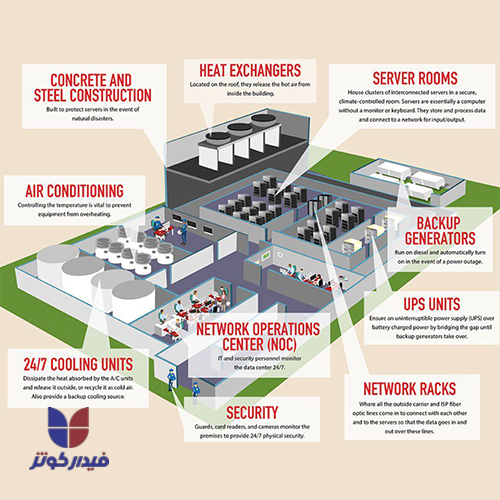
In today's digital world, data is recognized as a valuable asset, and the creation and management of a data center is vital for companies and organizations. Data centers play a vital role in providing online services, storing sensitive information, and supporting various processes. From online stores to social networks and financial services, everyone relies on data centers as their beating heart.
Data center design standards play a very important role as a main guide for creating and operating data centers. These standards provide detailed requirements and guidelines for various dimensions of the data center, including physical space, equipment, and infrastructure.
These standards, which were developed by reputable organizations such as TIA, BICSI and ASHRAE, provide comprehensive and efficient guidelines for the design and implementation of data centers. In this article, we will examine the importance of data center design standards, introduce the most common and We discuss the most important standards of data centers as well as key requirements in data center design based on standards in a complete and comprehensive manner
In today's digital world, data centers play a vital role in the functioning of businesses and organizations. These massive centers house huge repositories of data and form the basis of online services, applications and critical processes. Due to the growing importance of data centers, compliance with their design and construction standards is of great importance.
Compliance with these standards can bring many benefits, including:
Cost reduction: Datacenters contain the most expensive equipment, and for this reason, optimizing energy consumption in them is of great importance. By focusing on things like efficient air conditioning and the use of high-efficiency equipment, the standards can significantly reduce energy consumption and minimize operating costs.
Increased sustainability: Adherence to electrical, cooling, and firefighting standards can prevent power outages, equipment failures, and data loss.
Improving security: Data centers are the main target of cyber attacks and information theft. Data center design standards help secure data and protect it from cyber threats by focusing on things like physical access control, security monitoring, and cryptographic technologies.
Improved performance: Data centers must be designed in such a way that they can process and move large volumes of data efficiently and without interruption. Standards help optimize data center performance and meet the growing needs of businesses by considering requirements such as network bandwidth, storage capacity, and processing power.
Adherence to data center design standards is a necessary and vital matter for any organization that seeks to ensure the safe, reliable and efficient operation of its data center. Because failure to comply with the standards can have unfortunate consequences, including power outages, loss of information, cyber attacks, reduced performance, and finally a sharp increase in costs and inefficiency of the center. We will go into more detail about the various data center design standards and how to implement them.
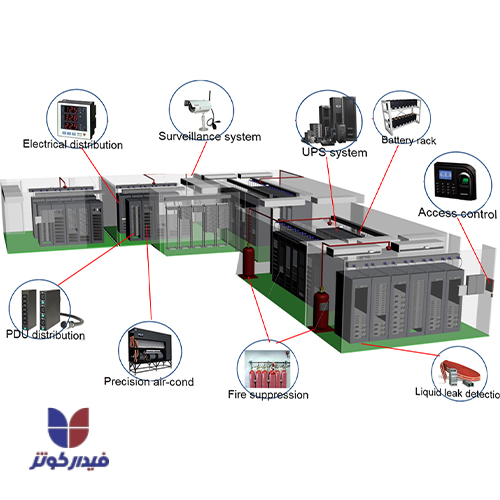
The world of data centers consists of a set of standards and guidelines, each of which addresses specific aspects of data center design, construction, and operation. Choosing the right standard for each project depends on various factors, such as the type of data center, budget, specific needs, and local regulations. .
In the following, we introduce some of the most common standards:
This standard was developed by the Telecommunications Industry Association (TIA) and is recognized as one of the most important and accepted standards in the field of data center design. TIA-942 covers a wide range of topics including the physical design of the data center space, power and cooling systems, security and cable management. The first edition of this standard was published in 1995 and has been continuously updated since then. This standard is used in all types of data centers, including small to large data centers and private and public data centers.
This standard, developed by the Building Communications Systems Industry Association (BICSI), focuses on the physical infrastructure of the data center, including cabling, racking, and electrical systems. BICSI 002 is popular among data center design and construction professionals due to its focus on technical details. The first edition of this standard was published in 1992 and has been continuously updated since then. This standard has paid attention to many details in the design and implementation of the data center. For example, attention has been paid to the water entering the building, the diameter of the pipe and even the place of garbage collection.
The Uptime Institute provides Tier standards for classifying data centers based on their level of reliability and stability. Tier levels are ranked from 1 to 4, with Tier 4 representing the highest level. Tier standards are critical for organizations that require uninterrupted data center performance, such as financial institutions and cloud service providers.
Level 1
Providing the most basic level of infrastructure with a single path for power and cooling systems
99.671% availability, equivalent to 28.8 hours of downtime per year
Level 2
Providing a slightly higher level of infrastructure with additional components
99.741% availability, equivalent to 22 hours of downtime per year
Level 3
Providing a significant level of infrastructure with multiple routes for power and cooling systems
99.982% availability, equivalent to 1.6 hours of downtime per year
Level 4
Providing the highest level of infrastructure with multiple paths for power and cooling systems as well as additional components
99.995% availability, equivalent to 26.3 minutes of downtime per year
The International Organization for Standardization (ISO) has developed an extensive set of standards for a wide range of industries, including data centers. Some of the ISO standards related to the data center are:
ISO 27001 serves as a guide to information security management and provides a framework for protecting critical information assets, including data, systems and networks. Focusing on the confidentiality, integrity, and availability of information, this standard helps organizations identify, assess, and mitigate security risks.
ISO 20000 focuses on service management and provides a framework for providing high quality and efficient IT services. This standard helps organizations effectively deliver and support their IT services by defining key processes such as incident management, problem management and change management.
ISO 22301 serves as a guide to business continuity management and provides a framework to ensure that critical activities can continue in the event of disruptions. By helping organizations identify and manage potential risks, such as natural disasters, system failures or cyber-attacks, this standard helps them ensure the continuity of their operations in difficult circumstances.
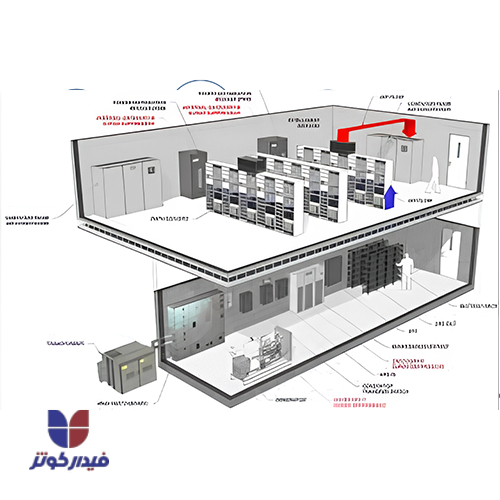
The American Society of Heating, Refrigerating, and Air-Conditioning Engineers (ASHRAE) provides standards for the design and performance of heating, cooling, and air-conditioning (HVAC) systems in data centers. ASHRAE standards are essential to ensure that data centers operate in appropriate temperature and humidity conditions.
Choosing the right standard for data center design depends on several factors, including the size and complexity of the data center, specific business needs, and available budget. Fidar Kowsar consulting engineers with years of experience are ready to provide expert advice for your data center
One of the data center design standards specifies requirements for data center power systems, including power supply, power distribution, backup systems, and lightning protection. These requirements are designed to ensure reliable and uninterrupted power supply to data center equipment.
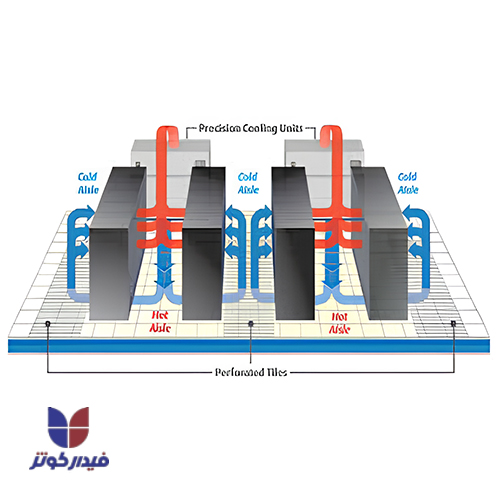
Specifies requirements for data center cooling systems, including chillers, fans, dehumidifiers, and temperature control systems. These requirements are necessary to maintain proper temperature and humidity inside the space and prevent overheating of sensitive equipment. Cooling systems should be placed at least 24 inches above the floor.
There are three main methods for distributing cold air in data centers, each with its own advantages and disadvantages:
Row Oriented System:
Room Oriented System:
Internal rack system (Rack Oriented):
Data center network infrastructure plays a vital role in transferring data between equipment and providing services to users. It specifies requirements for network infrastructure, including cables, switches, routers, and firewalls. These requirements are designed to ensure the proper functioning of the network and the exchange of information in the data center.
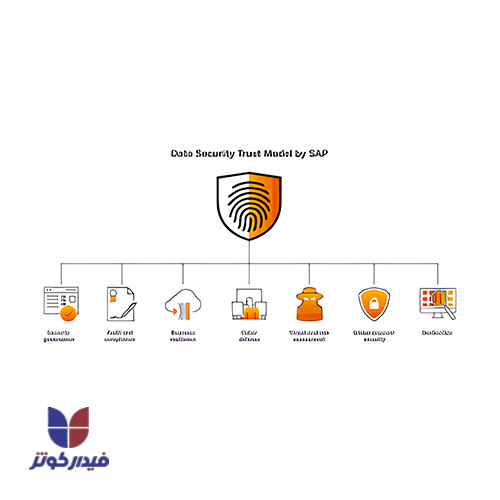
Data center security is of utmost importance as it protects sensitive data and equipment from a wide range of threats, including fire, theft and cyber attacks.
A limited number of people should be allowed to access and enter the data center and server room
The use of locks (electronic or biometric), identification cards, video surveillance systems and 24-hour patrols are necessary to prevent unauthorized people from entering the data center.
Use locks or protective shelves for racks
For information security, measures such as data encryption, data access control, and firewalls should be implemented.
Use of ISMS, CSC, NIST guidelines that are developed to manage and protect information against cyber threats in an organization, including data centers.
Data centers must be equipped with firewalls, intrusion detection systems (IDS) and intrusion prevention systems (IPS).
For information security, measures such as data encryption and data access control should be implemented
Specifies requirements for fire suppression systems, including type of fire suppression system, location of detectors and sprinklers, and emergency evacuation procedures. These requirements are necessary to minimize the risk of fire and protect equipment and data in the event of a fire.
The last item in the requirements of the data center design standards is supervision and monitoring. To maintain the security and correct and uninterrupted operation of the data center, it is necessary to effectively supervise and monitor the data center.
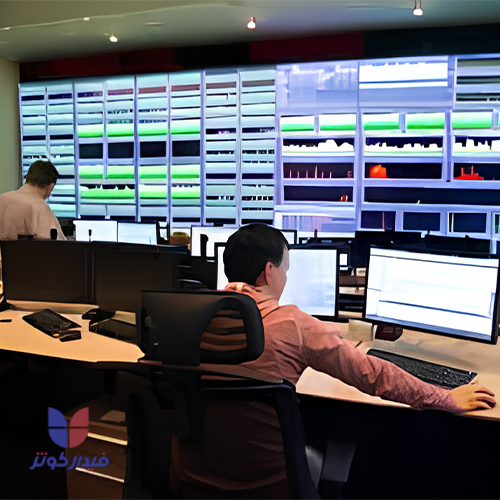
BMS (Building Management System) intelligent management systems automatically perform many tasks related to data center monitoring and control. According to the TIA-942 standard, it is necessary and necessary to use BMS in the data center.
Some of the benefits of using BMS are:
Increased efficiency: It can automatically perform various tasks such as adjusting temperature and humidity, turning equipment on and off, and power management.
Cost reduction: BMS can help operators optimize their energy consumption and reduce operating costs.
Improved reliability: The system can automatically detect and resolve problems and prevent breakdowns.
In today's busy and complex world, building and maintaining a stable and secure data center is very important for any organization. The use of data center design standards not only serves as an important guide for building and managing data centers, but also as a long-term investment in the security and efficiency of information systems.
Compliance with data center design standards allows organizations to take care of their digital assets with better confidence and provide high-quality online services. Especially at a time when emerging technologies such as the cloud, the Internet of Things, and artificial intelligence are expanding rapidly, these standards are vital as a valid guide for creating a stable and reliable information infrastructure.
In this article, we reviewed the key requirements and guidelines related to data center design in the framework of various standards. Standards such as TIA-942, BICSI 002, Tier, ISO and ASHRAE each provide a roadmap for building and maintaining modern and reliable data centers by providing expert guidance on various areas, from physical space to equipment and infrastructure.
If you are planning to build a new data center or upgrade your existing data center, we strongly recommend you to consult experienced experts in this field. Using the knowledge and experience of its specialists, Fidar Kowsar Company is ready to provide consulting and services for the design and construction of data centers based on the highest global standards. Contact us to talk more about your data center needs and benefit from our specialized solutions to design and build a stable, efficient and secure data center.
بعد از ورود به حساب کاربری می توانید دیدگاه خود را ثبت کنید